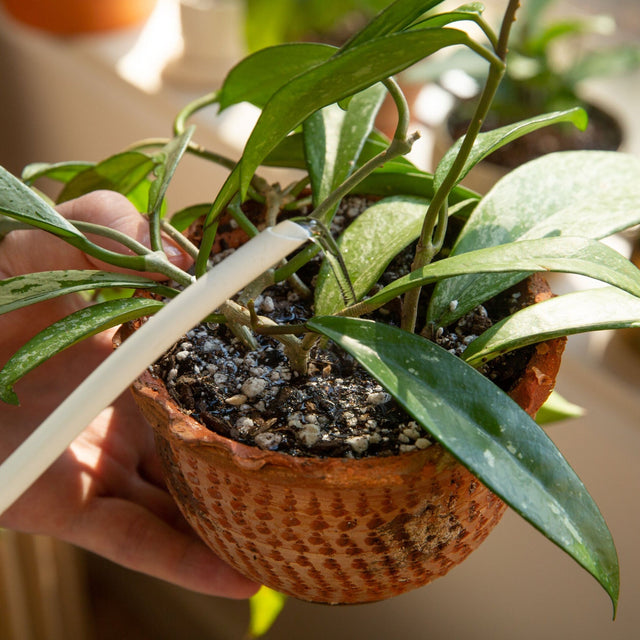If you’ve ever searched for a battery powered grow light or cordless grow lights, you’re not alone. Gardeners all over the internet from Reddit threads to YouTube comment sections have asked the same question: Why can’t I just get a rechargeable grow light for that one plant in the corner, far from a plug?
It sounds like it should be simple, a neat, wireless grow light you can set up above your favourite plant, giving it the extra boost it needs. Unfortunately, the reality is more complicated.

Why no cordless grow lights are available
The main reason is energy demand.
Plants, especially those that need a boost from grow lights, require far more light energy than a desk lamp or fairy lights can provide. A good grow light for even a small plant will often need 18-40 watts of power.
Let’s do the math:
- A 20W light running for 10 hours = 200 watt-hours (0.2 kWh) of electricity.
- A typical large power bank rated at 20,000 mAh (at 5V) stores about 100 watt-hours of usable energy.
- That means you’d get roughly half a day of runtime at full brightness before needing to recharge.
Even stepping up to a 40,000 mAh power bank (~200 Wh) only gets you one day of runtime before recharging.
And that’s with a relatively small light, anything stronger would drain the battery even faster.
This is why most “cordless grow lights” are either:
- Low-wattage USB lights (5–10W) that can run a bit longer but provide limited light intensity.
- Products that still need to be plugged in most of the time.
The Environmental Problem with batteries
Even if you find a battery powered setup that works for a few hours, there’s another issue, the environmental cost.
Rechargeable lithium-ion batteries:
- Require mining of rare earth metals like lithium and cobalt, which has a significant ecological footprint.
- Have a limited charge cycle life (typically 300–600 charges before noticeable degradation).
- Are notoriously difficult to recycle, many end up in landfill, where they can leak toxic materials.
When you factor in the inefficiency of charging (often wasting 20–30% more electricity than a direct plug-in light), battery setups are less eco-friendly than simply running a low-wattage LED from the mains.
What Gardeners Actually Do Instead
From discussions with plant enthusiasts (we get asked about cordless grow lights alot!), here are the practical alternatives people use:
1. USB Grow Light + Power Bank (with major caveats)
On paper, this seems like the perfect compromise: a small halo-style USB grow light paired with a large power bank (20,000–40,000 mAh). In practice, the limitations show up fast.
Most USB grow lights are very low output, typically just 5–10 watts, and lack the intensity for anything but the most shade-tolerant plants. Even then, you’ll often need to place the light just a few inches from the leaves. Anything stronger, like a 20W light quickly exposes the problem:
- A 20W light running for 10 hours uses 200 watt-hours (0.2 kWh).
- A large 20,000 mAh power bank holds roughly 100 watt-hours of usable energy—enough for about 5 hours of runtime.
- Even a 40,000 mAh power bank (~200 Wh) would give you only one day before you need to recharge.
This approach could work for short-term setups (quarantine plants, temporary lighting in bathrooms or hallways) but is not a sustainable long-term solution for most growers.
2. Discreet Extension Cables
Of course we understand this wont work in some situations, but a high-quality extension cable run neatly along skirting boards, under rugs, or even behind furniture can bring power to that perfect plant spot.
- Use a good quality extension lead if running power across a room. For small LED grow lights, cable thickness isn’t critical, but a sturdier lead will be more durable and safer over time.
- Add a timer for automated light cycles.
3. Relocation
It’s not what you wanted to hear, and not a useful tip but unfortunately many plant owners in this situation end up doing just that, moving plants closer to natural light sources or nearer spots where they can be plugged into a socket or extension lead. While it may take some creative rearranging, it’s often the simplest way to give plants the light they need without the constant hassle of recharging batteries.
4. Grow Gang’s Position on Battery-Powered Lights
We’ve had plenty of customers ask why we don’t offer a cordless grow light.
Right now, the practical limitations (low output, short run times, daily recharging) combined with the environmental cost of battery production and disposal make it a poor fit for most growers.
That’s why at Grow Gang, we’ve chosen not to develop a battery-powered model, for now. We are keeping a close eye on battery technology developments, and if a greener, higher-capacity solution becomes viable, we’ll be ready to revisit the idea.
In the meantime, our plug-in LED grow lights are:
- Highly energy-efficient
- Long-lasting
- Easy to use with extension leads and timers for maximum placement flexibility
The Bottom Line
Battery powered grow lights are more of a wish-list item than a practical reality.
For most plant lovers, the better path is:
- Reduce power needs by placing plants where they get some natural light, or grouping them under other grow light set ups.
- Use efficient plug-in LEDs with extension cords or clever routing.
- Avoid the environmental downsides of disposable or short-lived rechargeable batteries if possible.
If you want to browse low-energy, high-output grow lights that work anywhere you can run a cable, check out our LED grow light collection. We promise they’ll keep your plants happy and keep your space looking good.
Mentioned in this article
More stories

Watering & Light Tips for Summer
